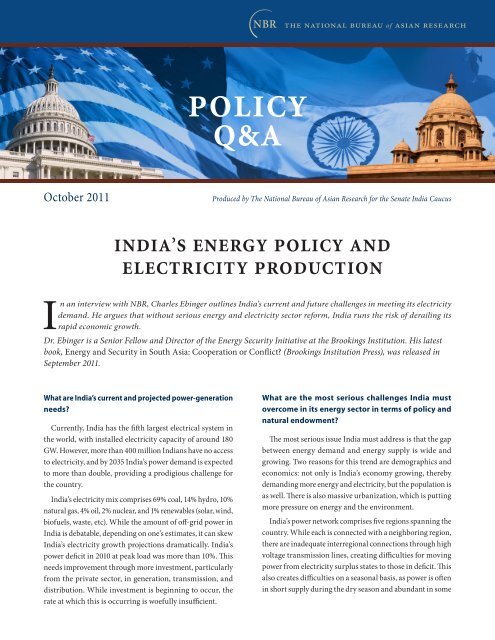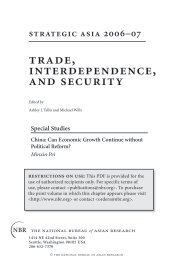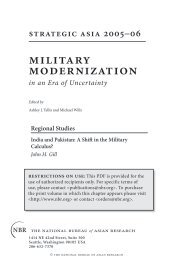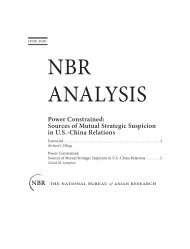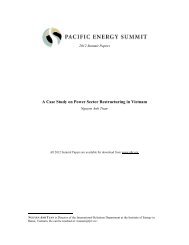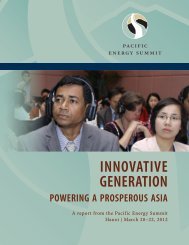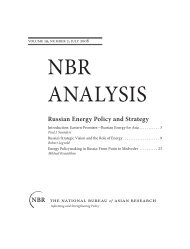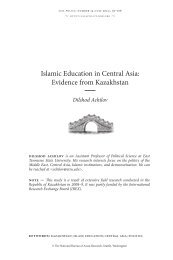India's Energy Policy and Electricity Production - The National ...
India's Energy Policy and Electricity Production - The National ...
India's Energy Policy and Electricity Production - The National ...
Create successful ePaper yourself
Turn your PDF publications into a flip-book with our unique Google optimized e-Paper software.
policy<br />
q&a<br />
October 2011<br />
Produced by <strong>The</strong> <strong>National</strong> Bureau of Asian Research for the Senate India Caucus<br />
india’s energy policy <strong>and</strong><br />
electricity production<br />
In an interview with NBR, Charles Ebinger outlines India’s current <strong>and</strong> future challenges in meeting its electricity<br />
dem<strong>and</strong>. He argues that without serious energy <strong>and</strong> electricity sector reform, India runs the risk of derailing its<br />
rapid economic growth.<br />
Dr. Ebinger is a Senior Fellow <strong>and</strong> Director of the <strong>Energy</strong> Security Initiative at the Brookings Institution. His latest<br />
book, <strong>Energy</strong> <strong>and</strong> Security in South Asia: Cooperation or Conflict (Brookings Institution Press), was released in<br />
September 2011.<br />
What are India’s current <strong>and</strong> projected power-generation<br />
needs<br />
Currently, India has the fifth largest electrical system in<br />
the world, with installed electricity capacity of around 180<br />
GW. However, more than 400 million Indians have no access<br />
to electricity, <strong>and</strong> by 2035 India’s power dem<strong>and</strong> is expected<br />
to more than double, providing a prodigious challenge for<br />
the country.<br />
India’s electricity mix comprises 69% coal, 14% hydro, 10%<br />
natural gas, 4% oil, 2% nuclear, <strong>and</strong> 1% renewables (solar, wind,<br />
biofuels, waste, etc). While the amount of off-grid power in<br />
India is debatable, depending on one’s estimates, it can skew<br />
India’s electricity growth projections dramatically. India’s<br />
power deficit in 2010 at peak load was more than 10%. This<br />
needs improvement through more investment, particularly<br />
from the private sector, in generation, transmission, <strong>and</strong><br />
distribution. While investment is beginning to occur, the<br />
rate at which this is occurring is woefully insufficient.<br />
What are the most serious challenges India must<br />
overcome in its energy sector in terms of policy <strong>and</strong><br />
natural endowment<br />
<strong>The</strong> most serious issue India must address is that the gap<br />
between energy dem<strong>and</strong> <strong>and</strong> energy supply is wide <strong>and</strong><br />
growing. Two reasons for this trend are demographics <strong>and</strong><br />
economics: not only is India’s economy growing, thereby<br />
dem<strong>and</strong>ing more energy <strong>and</strong> electricity, but the population is<br />
as well. <strong>The</strong>re is also massive urbanization, which is putting<br />
more pressure on energy <strong>and</strong> the environment.<br />
India’s power network comprises five regions spanning the<br />
country. While each is connected with a neighboring region,<br />
there are inadequate interregional connections through high<br />
voltage transmission lines, creating difficulties for moving<br />
power from electricity surplus states to those in deficit. This<br />
also creates difficulties on a seasonal basis, as power is often<br />
in short supply during the dry season <strong>and</strong> abundant in some
<strong>Policy</strong> Q&A<br />
regions during the monsoon but cannot be moved to help<br />
other states.<br />
An additional complication is that India’s investment in<br />
power transmission <strong>and</strong> distribution has not kept up with<br />
generation. Thus, in some cases, new generation cannot<br />
move to the market because of transmission bottlenecks,<br />
such as with wind power in Tamil Nadu.<br />
India’s power sector is also plagued by the dual responsibility<br />
of the states <strong>and</strong> the federal government. Power produced<br />
<strong>and</strong> sold in the same state is subject to the oversight of the<br />
State <strong>Electricity</strong> Board <strong>and</strong> the State <strong>Electricity</strong> Regulatory<br />
Commission, whereas power sold between states is subject<br />
to federal oversight <strong>and</strong> regulation. As of September 2011,<br />
about 46% of generating capacity was owned by the states,<br />
31% by central government institutions, <strong>and</strong> 23% by the<br />
private sector. Complicating this situation is that there<br />
are far too many state <strong>and</strong> federal institutions involved in<br />
energy decision-making. In the absence of a single institution<br />
responsible for the energy sector, comprehensive <strong>and</strong> sound<br />
policymaking is impossible.<br />
Although domestic energy supplies exist, some are limited<br />
in amount (e.g., oil) <strong>and</strong> others (e.g., coal) are located in areas<br />
where they are geologically <strong>and</strong> technically hard to extract.<br />
In the case of coal, although India has large reserves, much<br />
of it is located far from dem<strong>and</strong> centers or in areas where<br />
insurgencies affect production.<br />
<strong>The</strong>se issues are further exacerbated by the country’s policies,<br />
politics, <strong>and</strong> infrastructure. For instance, coal resources, far<br />
from their final market, must depend on India’s dilapidated<br />
railroad infrastructure that is prone to delays. Many power<br />
plants cannot get enough coal <strong>and</strong> must rely on the expensive<br />
spot market or risk power shortages. At a recent talk here<br />
in Washington, D.C., Vikram Mehta, Chairman of Shell<br />
India, mentioned that coal stocks at roughly 60% of India’s<br />
thermal plants were only enough for a seven-day supply.<br />
Many plants only have a one-day supply.<br />
In the case of oil <strong>and</strong> natural gas, the problem is pricing <strong>and</strong><br />
infrastructure. Because India’s government has not created a<br />
positive climate for foreign investors, the country’s reserves<br />
have not benefited from the best technology <strong>and</strong> expertise<br />
available. This hurts production. Whereas the average recovery<br />
rate of oil in the global petroleum industry is 40%, in India<br />
it is only 28%. One way India can promote exploration <strong>and</strong><br />
production is through pricing reform: currently, private<br />
Charles Ebinger<br />
<strong>The</strong> Brookings Institution<br />
Director, <strong>Energy</strong> Security Initiative <strong>and</strong> Senior<br />
Fellow, Foreign <strong>Policy</strong><br />
Dr. Charles Ebinger has more than 35 years<br />
of experience specializing in international<br />
<strong>and</strong> domestic energy markets (oil, gas,<br />
coal <strong>and</strong> nuclear) <strong>and</strong> the geopolitics of<br />
energy, with a particular focus on South<br />
Asia, the Middle East, Africa, the Arctic<br />
<strong>and</strong> Antarctic. He has served as an energy<br />
policy advisor to over 50 governments on<br />
restructuring their state-owned energy<br />
sectors, privatization <strong>and</strong> the creation<br />
of regulatory regimes. He is an adjunct<br />
professor of electricity economics at<br />
Johns Hopkins Nitze School <strong>and</strong> is one<br />
of the Nuclear <strong>Energy</strong> Institute’s “Nuclear<br />
<strong>Energy</strong> Experts.”<br />
sector investors have no incentive to invest in India due<br />
to poor returns on investment. Similarly, the government<br />
has not invested enough in infrastructure: its gas pipeline<br />
network is woefully under-connected, <strong>and</strong> although the<br />
situation is slowly improving, large parts of India’s south<br />
<strong>and</strong> northeast are not connected to a gas grid.
<strong>Policy</strong> Q&A<br />
Moreover, India must also enforce regulations against<br />
energy <strong>and</strong> electricity wastage <strong>and</strong> cheating. Often it is the<br />
wealthy l<strong>and</strong>lords who waste free <strong>and</strong> cheap electricity rather<br />
than the poor farmers it was intended to help. Bribes are often<br />
paid to meter-readers, <strong>and</strong> many government <strong>and</strong> military<br />
buildings <strong>and</strong> offices pay no electricity fees at all. Providing<br />
regulators with enforcement capacity would dramatically<br />
curb consumption <strong>and</strong> increase efficiency.<br />
One final issue is the l<strong>and</strong> acquisition bill under debate<br />
in India. This bill must be comprehensive <strong>and</strong> fair to both<br />
owners <strong>and</strong> purchasers. Most importantly, however, it<br />
must be transparent <strong>and</strong> enforceable. While India’s energy<br />
sector is improving, the biggest problem for investors is that<br />
translucent regulations <strong>and</strong> processes drive up private sector<br />
costs. A clear <strong>and</strong> egalitarian bill can accelerate projects in<br />
the national interest while providing fair compensation for<br />
those displaced.<br />
If India continues on its current trajectory, what might<br />
be the impact on economic growth<br />
As I explain in my book <strong>Energy</strong> <strong>and</strong> Security in South Asia:<br />
Cooperation or Conflict (2011), if India does not embark on<br />
serious energy <strong>and</strong> electricity sector reform, it runs the risk of<br />
a sociopolitical explosion. Given both its tremendous economic<br />
growth fueled by energy <strong>and</strong> the equally large poverty rate,<br />
addressing these issues is perilous. Manufacturing, industrial<br />
production, finance, <strong>and</strong> commerce cannot function without<br />
energy. Similarly, energy access can provide a lifeline <strong>and</strong><br />
an opportunity for economic development.<br />
India’s energy <strong>and</strong> electricity shortages have already rattled<br />
private sector investors. <strong>The</strong>y still invest because India’s<br />
“Foremost, the world must<br />
acknowledge that India’s<br />
dem<strong>and</strong> for commercial energy<br />
is surging. Given the country’s<br />
many technical, economic, <strong>and</strong><br />
political constraints, for the<br />
next few decades this dem<strong>and</strong><br />
will be met by fossil fuels.”<br />
opportunities are so expansive, but if energy sector reform<br />
does not occur <strong>and</strong> energy provision does not become more<br />
reliable, investment may dry up.<br />
Moreover, any stagnation in India’s growth rate due to<br />
energy insecurity can have very damaging effects on the<br />
country’s stability. Already India faces challenges from<br />
domestic insurgencies <strong>and</strong> has tenuous borders with Pakistan,<br />
Bangladesh, Nepal, <strong>and</strong> China. Additional insecurity due<br />
to a lack of economic opportunity could be devastating.<br />
What measures can India take to reduce carbon<br />
emissions <strong>and</strong> the environmental impact of rising<br />
energy consumption<br />
Foremost, the world must acknowledge that India’s dem<strong>and</strong><br />
for commercial energy is surging. Given the country’s many<br />
technical, economic, <strong>and</strong> political constraints, for the next<br />
few decades this dem<strong>and</strong> will be met by fossil fuels.<br />
India <strong>and</strong> its neighbors are among the countries most atrisk<br />
from the impacts of climate change. <strong>The</strong>re are a number<br />
of measures New Delhi can take to curb energy consumption<br />
<strong>and</strong> reduce related environmental impacts, but all will require<br />
political courage <strong>and</strong> massive consensus-building. At the<br />
risk of sounding like a Cass<strong>and</strong>ra, India must take action<br />
on all fronts.<br />
India, to the greatest degree possible, must liberalize<br />
all wholesale <strong>and</strong> retail prices. As long as energy remains<br />
free or cheap, consumers have no incentive to use it wisely,<br />
conserve, or buy energy-efficient appliances <strong>and</strong> vehicles. To<br />
that point, India should m<strong>and</strong>ate more stringent efficiency<br />
st<strong>and</strong>ards for appliances, vehicles, <strong>and</strong> all new commercial,<br />
residential, <strong>and</strong> industrial buildings, with encouragement<br />
through fiscal <strong>and</strong> other promotional polices. <strong>The</strong> country<br />
should also enact policies that encourage energy retrofits of<br />
existing residential <strong>and</strong> commercial buildings.<br />
Similarly, India should move to increase the efficiency<br />
of all its power plants to conform to international norms.<br />
Investment in a more efficient electricity grid would do<br />
wonders for both its energy security <strong>and</strong> the environment.<br />
Rather than building new generation facilities, most of them<br />
carbon-emitting, India could deliver more electricity to the<br />
end consumer. Today, India’s transmission <strong>and</strong> distribution<br />
losses are astounding.
<strong>Policy</strong> Q&A<br />
When widening energy access, one challenge will be<br />
deploying as much clean energy as technically feasible. One<br />
great opportunity—for rural communities in particular—<br />
is distributed generation or isolated renewable energy<br />
installations.<br />
India must accept the conflict that the country will be<br />
largely dependent on fossil fuels for the foreseeable future<br />
but that the reality of climate change is equally inescapable.<br />
To that end, in concert with the United States, India should<br />
take the lead in establishing a world-class carbon capture<br />
<strong>and</strong> sequestration research <strong>and</strong> demonstration program.<br />
This will help commercialize a technology that addresses<br />
a fundamental reality of the world’s energy consumption:<br />
fossil fuels will be a staple for decades to come.<br />
What potential is there for both domestic <strong>and</strong> foreign<br />
private sector investment to help meet India’s growing<br />
energy dem<strong>and</strong><br />
<strong>The</strong>re is a tremendous opportunity, but only if a government<br />
emerges in New Delhi that can free the Indian economy from<br />
its past ideological shackles. While the federal government<br />
publicly embraces private sector investment, it is often loath<br />
to give up the reins in many industries. New Delhi must<br />
allow private investment to introduce the best technology<br />
<strong>and</strong> operational efficiencies that are integral to building a<br />
more responsive energy sector.<br />
Where India has made private-sector friendly reforms, the<br />
results have been spectacular. India’s biggest gas discovery<br />
was made by a private sector firm. <strong>The</strong> initial public offering<br />
of Coal India raised billions in private investment for the<br />
government. Yet for all the excitement generated, the Indian<br />
bureaucracy still slows the implementation of reforms. In<br />
addition, as the poor are often the most affected by changes<br />
from industry, the government must minimize the impact<br />
of price rationalization on them. This can be done through<br />
more targeted subsidies <strong>and</strong> better enforcement.<br />
What are the respective roles of the central government<br />
<strong>and</strong> Indian states in establishing <strong>and</strong> carrying out<br />
energy policy<br />
In India, each state has authority over policy decisions<br />
governing how energy is produced, moved, <strong>and</strong> consumed<br />
within its borders. A state can, in effect, set prices for<br />
“Moreover, any stagnation<br />
in India’s growth rate due to<br />
energy insecurity can have<br />
very damaging effects on the<br />
country’s stability.”<br />
generation, transmission, <strong>and</strong> distribution. Generally, the<br />
prices for the fuel itself are set by the central government<br />
or other parastatal institutions. However, if a state wishes<br />
to subsidize these prices, which often occurs, it can charge<br />
consumers less than it pays for the fuel. Due to this fact,<br />
almost all the state electricity boards are bankrupt.<br />
<strong>The</strong> central government is in charge of a number of public<br />
sector undertakings that produce <strong>and</strong> distribute energy<br />
<strong>and</strong> electricity. However, as these companies are forced<br />
to sell their products at subsidized rates, the government<br />
compensates them for their “under-recoveries,” which deflates<br />
the government’s fiscal coffers. <strong>The</strong> central government also<br />
supports the nationally owned firms that own <strong>and</strong> build<br />
power plants. <strong>The</strong>re are a host of other government-owned<br />
<strong>and</strong> state-owned corporations that are involved in the energy<br />
sector. <strong>The</strong> central government not only creates the rules<br />
under which these corporations operate but also ensures<br />
that the organizations themselves operate effectively <strong>and</strong><br />
are responsive to the needs of India’s citizens.<br />
How important is regional cooperation for India’s<br />
energy security<br />
While India needs to reform its energy sector for short<strong>and</strong><br />
medium-term energy security, regional cooperation<br />
will be vital in the long run. India must avoid the trap<br />
of forming an autarchic energy policy as there are great<br />
opportunities for energy collaboration with its neighbors,<br />
such as trading hydroelectricy with Nepal, natural gas <strong>and</strong><br />
coal-generated electricity with Bangladesh, natural gas<br />
with Iran <strong>and</strong> Turkmenistan through Pakistan, undersea<br />
gas with Oman, gas with Myanmar, <strong>and</strong> coal-generated<br />
electricity with Pakistan. While each opportunity raises<br />
a host of geopolitical <strong>and</strong> foreign policy issues, all must<br />
be examined seriously if India has any hope of meeting its<br />
burgeoning energy dem<strong>and</strong>.
<strong>Policy</strong> Q&A<br />
For example, just over the border from India’s industrial<br />
heartl<strong>and</strong> in Gujarat, the Thar Desert contains one of the<br />
largest coal deposits in the world. If developed, Pakistan<br />
could sell the coal to India <strong>and</strong> in return India could sell<br />
electricity back to Pakistan’s energy-starved province of<br />
Punjab. Not only does this make energy sense, it could start<br />
to assuage some of the region’s existing tensions. We must<br />
remember: India <strong>and</strong> Pakistan agreed to the Indus Water<br />
Treaty in 1960. While not perfect, this strategy offers hope<br />
for a win-win regional collaboration.<br />
“While India needs to reform<br />
its energy sector for short- <strong>and</strong><br />
medium-term energy security,<br />
regional cooperation will be<br />
vital in the long run.”<br />
ABOUT THE NATIONAL BUREAU OF ASIAN RESEARCH<br />
Founded in the legacy of Senator Henry M. Jackson, NBR provides Members of Congress <strong>and</strong> their staff with the highest<br />
quality Asia expertise through policy-relevant research <strong>and</strong> private <strong>and</strong> public briefings with our network of experts.<br />
NBR is a non-profit, non-partisan research institution headquartered in Seattle, Washington with a second office in<br />
Washington D.C. More information on NBR can be found at www.nbr.org.<br />
For information on NBR’s programs on Capitol Hill, please contact Sonia Luthra, Assistant Director for Outreach, at<br />
NBRdc@nbr.org or (202) 347-9767.<br />
the national bureau of asian research<br />
seattle <strong>and</strong> washington, d.c.<br />
nbr@nbr.org, www.nbr.org<br />
1414 ne 42nd street, suite 300<br />
seattle, washington 98105 usa<br />
phone 206-632-7370, fax 206-632-7487<br />
1301 pennsylvania avenue nw, suite 305<br />
washington, d.c. 20004 usa<br />
phone 202-347-9767, fax 202-347-9766


